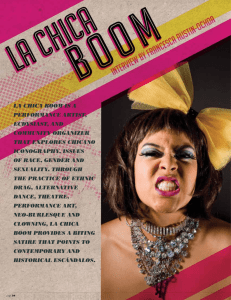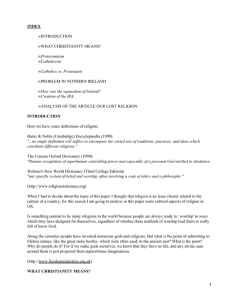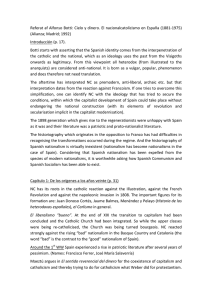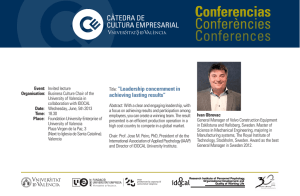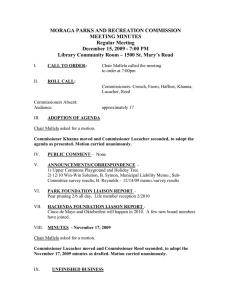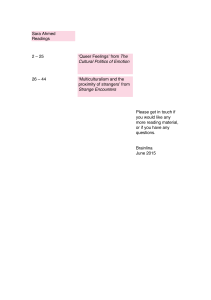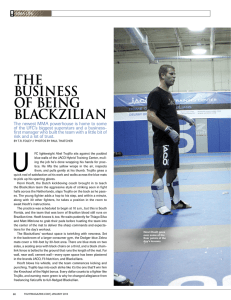Queer like La Virgen: Catholicism and Lesbian Sexuality in Carla
Anuncio
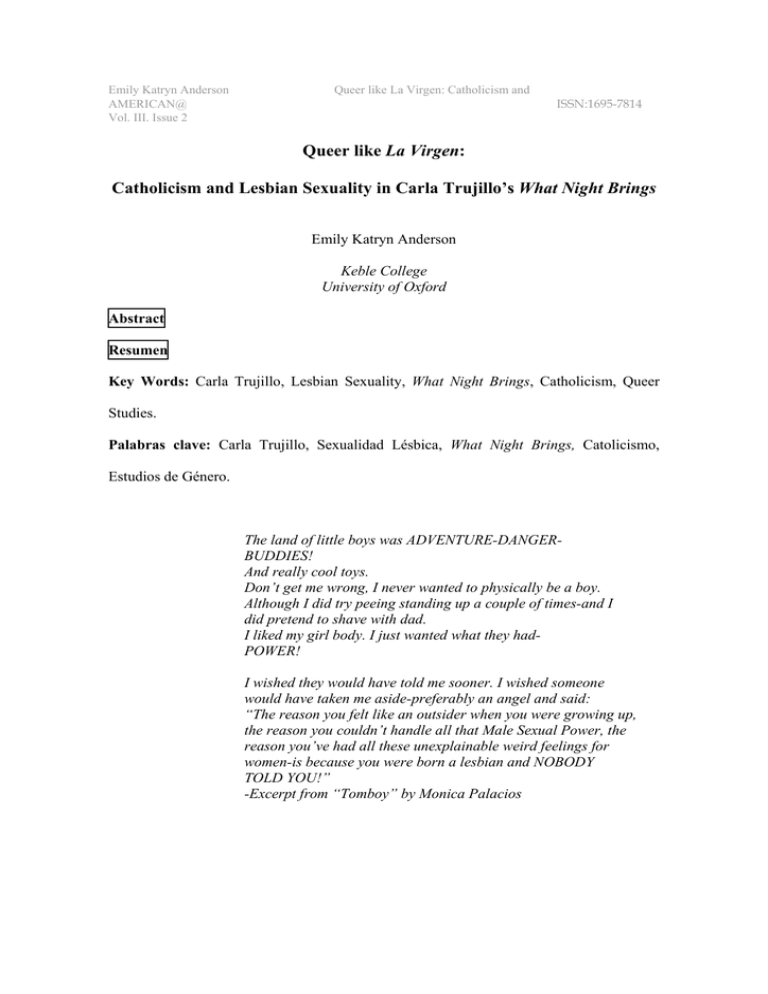
Emily Katryn Anderson AMERICAN@ Vol. III. Issue 2 Queer like La Virgen: Catholicism and ISSN:1695-7814 Queer like La Virgen: Catholicism and Lesbian Sexuality in Carla Trujillo’s What Night Brings Emily Katryn Anderson Keble College University of Oxford Abstract Resumen Key Words: Carla Trujillo, Lesbian Sexuality, What Night Brings, Catholicism, Queer Studies. Palabras clave: Carla Trujillo, Sexualidad Lésbica, What Night Brings, Catolicismo, Estudios de Género. The land of little boys was ADVENTURE-DANGERBUDDIES! And really cool toys. Don’t get me wrong, I never wanted to physically be a boy. Although I did try peeing standing up a couple of times-and I did pretend to shave with dad. I liked my girl body. I just wanted what they hadPOWER! I wished they would have told me sooner. I wished someone would have taken me aside-preferably an angel and said: “The reason you felt like an outsider when you were growing up, the reason you couldn’t handle all that Male Sexual Power, the reason you’ve had all these unexplainable weird feelings for women-is because you were born a lesbian and NOBODY TOLD YOU!” -Excerpt from “Tomboy” by Monica Palacios Emily Katryn Anderson AMERICAN@ Vol. III. Issue 2 Queer like La Virgen: Catholicism and ISSN:1695-7814 I open this article exploring the intersections between religion and queer identity in Carla Trujillo’s What Night Brings with an excerpt from Monica Palacios’s poem “Tomboy” because I think it distills two main ideas that are at the crux of Trujillo’s novel. Firstly, the poem features a young lesbian protagonist who realizes that her erotic leanings are in someway different from those embraced by her family and her culture at large, and it is this difference, she realizes, that equips others with power, and relegates her to a relative state of disempowerment. The subject in Palacios’s poem, like the character of Marci in What Night Brings, longs for maleness, not as an end in itself, but more because of the freedom it allows its owner, especially in regards to engaging in relationships with women. Also similar to Marci, Palacios’s character uses religious symbols and teachings to finally locate and identify what precisely the difference in her sexual orientation is. In “Tomboy,” Palacios states that had she been in charge of her journey into sexual consciousness, she would have chosen to be informed about her queerness by an angel, not unlike the way that Marci prays to God, Mary, and Baby Jesus to transform her into a boy so that she can “like girls,” as she puts it, without negative social repercussions. Since Marci does not find initial validation of her queer identity within her family or her community, she turns to her church and her spirituality in order to create a space in which she can explore the implications of her homosexuality. She demands this nurturance from the church, and for the most part, the church provides, even if Marci has to do quite a lot of revising of patriarchal religious ideologies in order to formulate the support she needs as she travels toward realizing her burgeoning queerness. 2 Emily Katryn Anderson AMERICAN@ Vol. III. Issue 2 Queer like La Virgen: Catholicism and ISSN:1695-7814 I. REPLANTING CULTURAL ROOTS: MORAGA AND CATHOLICISM Chicana writing about Catholicism and the lesbian’s place in it is not a new phenomenon. Writers such as Cherrie Moraga and Gloria Anzaldua have written about the role that religion has played in the shaping of their identities as Chicanas, often critiquing it for its sexism and homophobia, but at the same time not entirely denouncing its ability to act as a source of cohesiveness within Chicana/o communities. Moraga especially seems to equate the particular brand of Mexican Catholicism that she experienced as a child as something solidly rooted and inseparable from her racial and ethnic identity. In Loving in the War Years Moraga describes the years she spent away from Catholicism as a time that she “grew white . . . and sought to free herself from her cultures claim on her (ii)” Clearly, it is not simply the church that she describes herself as fleeing, but the Chicana/o community as a whole. For her, Catholicism seems to provide an opportunity to assert and embrace Chicana identity, while Protestantism or Agnosticism are religions she consistently equates with whiteness. When writing about her white college friends, she states that “they had enough privilege to be atheists” (55), implying that those who already have a relatively high degree of social, racial, political, or class power have less of a reason to seek out the emancipatory potential within communities of faith, whereas she was in a position to use the church as a tool for cultural and political coalition building. This coding of Protestantism as white is something that Trujillo seems to incorporate into What Night Brings when she details Marci, and here sister Korin’s interactions with Miss Patt, a white evangelical Baptist who, after asking Marci if her 3 Emily Katryn Anderson AMERICAN@ Vol. III. Issue 2 Queer like La Virgen: Catholicism and ISSN:1695-7814 name is “Spanish,” tells her “well, never you mind. Jesus loves everybody” (51). Miss Patt’s racism coupled with Marci’s mother’s admonishment to stop rubbing shoulders with “Okie-holy-roller-hootenanny” (55) seems to send a message, if not to Marci, at least to the reader, that Catholicism is the only suitable religion for a young Chicana. Indeed after hearing about Marci’s meeting with Miss Patt, her mother informs her that the “only type of prayer meeting [she’s] allowed to go to from then on are the prayer meetings at [her] own church” (55). It is questionable, however, if Marci’s mother would be as apt to send her catechism classes, communion, or confession if she knew the ways Marci was using Catholicism and its teachings as a space where her own queerness could be interrogated and realized. In Loving in the War Years, Moraga writes about visiting a Mexican basilica, and witnessing women who refuse to be herded off the moving platform underneath the Virgin’s feet, but rather hold onto the side rails and determine that they will not leave until they have paid proper tribute to the Virgin (ii). This image of women, determined not to compromise their worship despite the “irreverence imposed by such technology” (ii) is comparable to Marci’s refusal, even as a child, to subscribe to a version of Catholicism that does not allow her to develop an understanding of her lesbian desire. Rather, she demands that the religion alter itself in such a way that will validate her own sexual identity, and what’s more she revises, recreates, or out rightly ignores sexist and homophobic ideologies so that she can directly recruit God in her quests to win the affections of the girls she is attracted to. Just as the women at the Mexican basilica refuse to allow the machinery of the church to relegate them to the status of just another visitor of the virgin, Marci will not 4 Emily Katryn Anderson AMERICAN@ Vol. III. Issue 2 Queer like La Virgen: Catholicism and ISSN:1695-7814 embrace a spirituality that tries to push her off the platform before she is ready, that is, before she receives from it what she believes it should deliver: materially, maleness, but emotionally, a realm where lesbian identity can be identified and understood. Although it could potentially be argued that Marci does not believe that she can simultaneously love god and women, as evidenced by her persistent entreaties to be changed into a boy, I believe her requests are more due to her ignorance regarding the fact that homosexuals exist, rather than any idea on her part that the church condemns homosexuals. In other words, her desire to be male is rooted in the fact that she sees this as the only possible way she can pursue her love for women, not because she believes that queerness and Catholicism can’t conceivably mix. II. FROM VIRGIN TO GODDESS: SHADES OF CATHOLICISM IN ANZALDUA’S SPIRITUALITY Somewhat differently from Moraga, who sees her Catholic faith as a cultural and ethnic marker, Anzaldua is more aggressively condemnatory of the Catholic church and does not appear to strike the same balance between critique and embracement that Moraga does. Anzaldua writes, “In my own life, the Catholic Church fails to give meaning to my daily acts, to my continuing encounters with the ‘other world.’ It and other institutionalized religions impoverish all life, beauty, pleasure. The Catholic and Protestant religions encourage fear and distrust of life and of the body; they encourage a split between the body and the spirit and totally ignore the soul; they encourage us to kill parts of ourselves” (59). Finding that Catholicism does not nourish the feminist and queer parts of her subjectivity, 5 Emily Katryn Anderson AMERICAN@ Vol. III. Issue 2 Queer like La Virgen: Catholicism and ISSN:1695-7814 Anzaldua writes in Borderlands, about a host of ancient Mexican goddesses who she has found more representative of her spiritual and political goals. Perhaps the one she devotes the most amount of time to in Borderlands is Coatlicue, a creator goddess tied closely to the image of serpents, fertility, and agricultural abundance (49). Anzaldua illustrates how these early Aztec goddesses were altered or changed by patriarchal influence so that they eventually came to represent nothing beyond dutiful mothers, but how originally Coatlicue, or “Lady of the Serpent Skirt” as Anzaldua refers to her, “contained and balanced the dualities of male and female, light and dark, life and death” (54). Anzaldua depicts Coatlicue as existing in a hybrid or in-between state, fluidly shifting genders in a way that is similar to what Marci prays for. Obviously as a poor child who has had minimal schooling, Marci does not have the knowledge or the power to create and write a religion that is solely hers, as Anzaldua does, but interestingly, Marci demands many of the same things from Catholicism that Anzaldua declares are tenants of her spirituality; a focus on the body, a validation of queerness, a nurturing presence in a life that is rife with abuse and alienation. In any case, this idea of striking a balance between different dichotomies, of embodying dualities that Anzaldua outlines is something that Moraga feels Catholicism can do in her life, and it is also seems to be a belief that Marci holds, although perhaps not totally consciously. All three women seems to be using religion as a site to balance a critique and an assertion of self, whether through the rewriting of patriarchal Catholicism or a replacement of it with an alternative spirituality. 6 Emily Katryn Anderson AMERICAN@ Vol. III. Issue 2 Queer like La Virgen: Catholicism and ISSN:1695-7814 III. WHAT NIGHT BRINGS: RETHINKING THE RELIGIOUS, INCORPORATING THE QUEER “During the long difficult night that sent my lover and I to separate beds, I dreamed of church and cunt. I put it this way because that is how it came to me. The suffering and the thick musty mysticism of the catholic church fused with the sensation of entering the vagina-like that of a colored woman’s-dark, rica, full-bodied. The heavy sensation of complexity. A journey I must unravel, work out for myself.” Loving in the War Years, Cherrie Moraga The connection between Catholicism and the female body is one that several Chicana writers have addressed, both in ways that illustrate the suppression and control that religion can exact over issues surrounding sexuality and reproduction, but also in ways that claim the Catholic woman’s body as fluid, complex, and a potential site of subversive re-creation of patriarchal religious ideologies and iconography. Carla Trujillo addresses this when she writes about how symbolism surrounding the Virgen de Guadalupe’s body has been re-appropriated by Chicana lesbians who ascribe alternative meanings to her traditional cultural role, rejecting her characterization as chaste and virtuous and instead reading her as a strong, rebellious, and possibly queer figure (“Virgen,” 218). Trujillo particularly notes that while the majority of priests may describe the Virgin as having no divine abilities, many Chicana women pray “directly to her, turn to her for answers to their prayers, for the bestowal of graces, and sometimes even for the miracle of physical healing” (“Virgen,” 221) 7 Emily Katryn Anderson AMERICAN@ Vol. III. Issue 2 Queer like La Virgen: Catholicism and ISSN:1695-7814 In an above passage, Moraga talks about entering a church in the same manner that she would have sex with a woman, with a particular focus on suffering, complexity, and reverence. This leads me to question how the connotations of being entered and altered by spirituality take on different meanings when compared metaphorically to lesbian sex. What happens when the female body becomes not a passive vessel to be penetrated by the ideologies or doctrines that relegate Mary or Guadalupe solely to the role of mother and virgin, but rather what are the implications when a woman’s body is allowed to moderate or control the aspects of religion she “lets in” and which ones she forces to remain on the periphery? Perhaps more subversively, what are the implications of a woman allowing a spirituality that is coded specifically as queer and female penetrate her body and her consciousness, creating a sexually-charged discourse in a space previously designated as an asexual, or at best, heterosexual territory? Trujillo argues that there is a significant difference between “enforced emulation of La Virgen in the classic manner which is obviously a means of repression” (220) and the ways in which many “lesbians claim La Virgen as [their] own, and take part of this creation of La Virgen and redefine her to suit [their] own needs” (220). It seems that this agency that the subject has to decide how to read religious codes could point to the differences inherent between forced or welcomed incorporation of already established religious symbolism or iconography. This creation of a feminist, queer, and yet still Catholic body is something that Marci embraces throughout What Night Brings. Early on in the novel, Marci informs the reader that were she to ever need a “Hollywood name,” she would choose between Mary Cross, Marci Christa, or Margi Cress” (6), all names that conjure up associations with 8 Emily Katryn Anderson AMERICAN@ Vol. III. Issue 2 Queer like La Virgen: Catholicism and ISSN:1695-7814 Mary, Christ, and the crucifixion. Interestingly, she is informed by others that she would need a new name as a way of hiding her Mexican descent from the show business community, but by choosing names that relate so closely to Catholic symbolism and iconography, she is subtly demanding that attention be paid to her culture and ethnicity, and avoiding the totalizing white-washing that Moraga claims her estrangement from Catholicism caused for her. Secondly, Marci contemplates taking on religiously charged names that emulate Mary or Christ, not as a way to show devoutness or holiness, not because she wants to fulfill some sexist ideal of feminine perfection, but because, strategically, she thinks she will need the name in order to “make it” in Hollywood and by extension, meet and pursue relationships with beautiful women (her internal monologue about seeking work in Hollywood immediately follows a lengthy rumination about the attractive women she sees on screen). Her emulation and incorporation of religion fits very much within Trujillo’s ideas about redefinition in order to meet one’s own specific needs—in Marci’s fantasy about going to Hollywood, she refuses to entirely separate her religion from her queerness, and instead decides to use religiously coded names in her pursuit of fame, and more importantly to her, women. Catholicism becomes a strategic tool she can use, if only in fantasy, to gain access to ways of living and loving that seem impossible within the strictures of her class, family, and ethnic community. Perhaps the most obvious way Marci literally puts her body in the hands of God is through her constant entreaties to God to make her male. In one of several such pleas Marci explains her actions in the following manner: “I went to the chapel and stood under 9 Emily Katryn Anderson AMERICAN@ Vol. III. Issue 2 Queer like La Virgen: Catholicism and ISSN:1695-7814 the statue of the Virgin Mary holding Baby Jesus . . . I lit a candle and started praying. ‘Mother Mary, please help me be a boy. I love girls so much and I need you and Baby Jesus to help God change me. Only you guys can do it. I promise to be good so please don’t forget me’” (30-1). Marci is obviously praying that her body will be enacted upon by religious forces, but again, for the specific desired result of allowing her to have sex with women. It can be argued that while her faith cannot physically turn her into a boy, it does provide the framework that she uses in her discovery of queer people and in her formulation of where she herself fits within this framework, and this will be explored further momentarily. However for the purposes of this argument about Catholic female bodies that literally subsume or absorb certain elements of the faith in order to fulfill specific ends, I would like to look briefly at Marci’s reaction when her Tia Leti catches her outside of Tink’s bar while she is attempting to take photographs of Eddie while engaged in his alleged affair with Wanda. In the hopes of pacifying her Aunt, Marci gives “her the same look Jesus had on the cross” (204), while informing the reader that she had “practiced it during mass when [she] was bored, telling the reader that she would also “point to other statues in the church and do their faces to make Corin laugh” (204). In both cases, Marci uses religious icons, internalized and manifested through her own body, as a means of either exacting influence over her Aunt or making her younger sister happy, both acts that she has deemed necessary and important. Marci consciously performs the religious, comically hyperbolizing familiar imagery, and through this masquerade, reshaping the purposes these images serve, transforming them from something that limits power to 10 Emily Katryn Anderson AMERICAN@ Vol. III. Issue 2 Queer like La Virgen: Catholicism and ISSN:1695-7814 something that grants it. Through her simultaneous embodying and performing of religion, Marci is enacting Luce Irigaray’s idea about constructing “the female imaginary [while at the same time] negotiate[ing] for its creation” (Perez 91). By this I mean that while Marci is literally creating a new religious “language” through the performance of Jesus and the other icons, she is also creating a space in which alternative readings of religion are allowed to exist. Even if her goals in appropriating the religious symbolic are not particularly profound, and are certainly self-focused, she still, by asserting her reading and performance, makes room for other systems of religious language and interpretation to be formed, something Irigaray believes has to happen if unitary, dominant meanings are ever to be challenged. In her article about Chicana Spiritualities, Lara Medina states that Chicana women and lesbians in particular “have learned to supplant patriarchal religion with their own cultural knowledge, sensibilities, and sense of justice” (189), something that Marci accomplishes when she decides, after seeing an autobiography of Christine Jorgenson, a white male to female transsexual, that she would rather keep asking God to change her sex even after learning that some people can create the change through sex reassignment surgery. Rather than accepting the idea that her religion would not condone her queerness, she resolves to, in her words “have another talk with Baby Jesus” (28) after deciding that the content in the autobiography was not representative of her specific desire “I didn’t want to go to the hospital and have an operation,” she writes, “I didn’t even really want a birdy. I just wanted Raquel” (28). Marci’s allegiance to her faith, her belief that religion is capable and will ultimately provide here with what she seeks in a more effective manner 11 Emily Katryn Anderson AMERICAN@ Vol. III. Issue 2 Queer like La Virgen: Catholicism and ISSN:1695-7814 than medical science, shows the extent to which she is able to rewrite Catholicism so that it allows for a woman to change her gender. Interestingly, Marci’s rejection of the image of Jorgenson, while based partly on a gender transformation that she finds lacking and incomplete (she notes for instance that if medical science can change people’s genitals than perhaps it should also be able to reduce other “mannish” aspects of Jorgenson’s appearance as well), also seems based on an alienation that she feels from Jorgenson’s whiteness. Marci is quick to note the copious blue eye shadow and Dusty Springfield haircut that Jorgenson sports on the cover of the book. Perhaps part of her gravitation towards a queerness grounded in Catholicism relates back to Moraga’s idea about Catholicism functioning as a way for Chicanas to assert culture and ethnicity. Since Jorgenson’s queerness and whiteness excludes her, Marci will construct her own racial and sexual identities within a context that she feels included in. Conversely, simply because Marci chooses religion as a vehicle for expressing her queerness, this does not lead her to an uncritical acceptance of the church, even if her critiques follow the candid manner of an eleven year old girl. She informs the reader that she “hate[s] stupid Holy Communion. Didn’t need it and didn’t want it,” she proclaims (124). Later in the novel she states that she suspects that Sister Elizabeth, a nun who teaches her catechism class, “makes up most of what she says about God, just to keep me believing in him. Either that or she thinks I am really dumb” (141). There are obviously several aspects or rituals within Catholicism that Marci finds no redeeming value in. Not coincidentally, these parts of the church that Marci rejects are resistant to the personalization of her own prayers and entreaties to God. She is told to stop asking 12 Emily Katryn Anderson AMERICAN@ Vol. III. Issue 2 Queer like La Virgen: Catholicism and ISSN:1695-7814 questions during catechism lessons because in the words of Mother Superior, her “questions do no good for anyone and cause the other children to doubt what they are being taught” (112). Sister Elizabeth, Mother Superior, and Mrs. Beauchaump (the Holy Communion teacher) all ask Marci to suppress her curiosity, deny her body, and become a passive receptacle for Christ through the act of communion, a ritual that Marci finds no meaning in and relegates to the same level of absurdity as barking like a dog, an action she assumes her Baptist neighbors engage in when they are worshipping. Her criticisms of the religion at this point are almost identical to those expressed by Anzaldua in Borderlands; however, instead of quitting Catholicism, Marci tends to focus on those parts, both institutionalized and personal, that provide her with the queer space that she is coming to realize she needs, while scornfully rejecting the aspects of the faith she finds meaningless or confining. I mention institutionalized queerness in the Catholic church in the above paragraph, because there do seem to be potential moments in the novel where Trujillo allows Marci’s queerness to be at least passively endorsed by Father Chacon, one of the priests at the church her family attends. When Marci, out of exasperation, admits to him during her first confession that she is attracted to girls (and would like to touch their breasts), and he does not condemn her, she expresses relief, stating, “I couldn’t believe what I was hearing. He said it was okay to squeeze chichis. I was happy” (72). However, seconds later Marci’s elation fades when she remembers that confession is anonymous; Father Chacon cannot see her face and may therefore think that he had just advised a young boy instead of her. The reader never discovers if Father Chacon knew that he was talking to Marci or not, and 13 Emily Katryn Anderson AMERICAN@ Vol. III. Issue 2 Queer like La Virgen: Catholicism and ISSN:1695-7814 this ambiguity calls into question whether there are spaces within institutionalized Catholicism for Marci to receive validation in her queer identity. This ambiguity regarding the church’s “official” position on homosexuality is complicated later in the novel when Marci begins to unravel definitions surrounding queerness and begins to suspect that Father Chacon is a homosexual. As readers we know this about him long before Marci has her first confession, so are therefore forced into the position of wondering throughout most of the novel if his refusal to denounce Marci’s homosexual desire is rooted in anti-homophobic sentiments on his part or merely upon the fact that he misrecognized her gender during the confession. Marci poses this question herself when she addresses the reader, asking them, Remember when I was in confession with father Chacon and I told him I liked girls and he didn’t even care? And remember I thought it was because he thought I was a boy? Well, maybe he knew I wasn’t. If he knew I was a girl and I said I liked girls, then can you see why he didn’t care? (136). Marci is questioning the presence of homosexuality within the core of the church itself, not merely as something that may exist on the outskirts. It certainly seems to be the case that Father Chacon’s relationship with Marci’s Uncle Tommy is an open secret, and by the end of the novel, even Marci has a shred of suspicion about the nature of their relationship. For Marci’s mother, Marci’s Aunt Arlene, and most of the other members of the community, the relationship between Tommy and Father Chacon is something viewed with tacit if grudging acceptance. Therefore there seems to be a space for male homosexuality within both the community and the church, although perhaps a less than 14 Emily Katryn Anderson AMERICAN@ Vol. III. Issue 2 Queer like La Virgen: Catholicism and ISSN:1695-7814 ideal space, judging by the fact that his relationship with Father Chacon seems to contribute to shame and silence in Tommy and alcoholism in his wife, Aunt Arlene. When Father Chacon hears Marci’s confession, it is unclear if he is trying to extend the queer space to include potential lesbians or not. Trujillo could have easily disclosed Father Chacon’s reasons behind his confession speech to Marci, but in not doing so, she leaves the potential for lesbian maneuvering room within Catholicism as a concrete reality, a negotiable space in which queer assignments of meaning can co-exist with opposing ideologies. Much of this paper has focused on the ways in which Marci refuses to separate her religion from her queerness, but instead how the two seem inextricable; however, Marci is not the only character in What Night Brings who seems unable to talk and think about queerness without embedding the assertions in religious language. In a conversation between Eddie, Marci, and her mother, the phrase “holly roller” becomes a euphemism for a homosexual when Eddie implies that Uncle Tommy is a holy roller because of all the time he “spends with priests” (74). Marci then assures Eddie that she is not a holy roller since she spends virtually no time with priests and does not like talking to them. Interestingly, interaction with father Chacon, is seen, through Eddie’s eyes at least, as something that may be contagious, a force that could potentially spread queerness to others. This is something that Marci assumes as well before she understands the definition of the word “queer” fully and wonders if Tommy might have become queer from the time that she saw him and Father Chacon exit from the same confessional booth. In these examples, queerness, like religion, is seen as something that people learn from others as 15 Emily Katryn Anderson AMERICAN@ Vol. III. Issue 2 Queer like La Virgen: Catholicism and ISSN:1695-7814 opposed to something that is innately part of them. For Marci, queerness, like religion, is learned, and what is more, it can be proselytized—those who are already queer can pass the knowledge onto others. After seeing Uncle Tommy physically attack Eddie after Eddie derisively accuses him of being queer, Marci realizes that queerness must be something undesirable, at least in the eyes of some. She proceeds to look up the word “queer” in the dictionary. Initially, and similar to her reaction to the Christine Jorgensen autobiography, Marci concludes that none of the definitions of “queer” that she finds in the dictionary are suitable descriptions of Uncle Tommy. While attempting to formulate a definition that makes sense to her, Marci relies upon the first definition of the word “queer,” which is “differing in some odd way from what is usual or normal” (134) and proceeds to analyze Uncle Tommy’s activities, finally deciding that that the only thing about him that fits this description is his devotion to the church. She thus concludes that it must be the priests, and by extension the church that makes people odd, abnormal, or queer. Finally she asserts that if the church and most of its followers are queer, than perhaps God is as well. While Marci has not yet reached the point of equating queerness to homosexuality, she is able to use religion as a gateway into understanding that queer people and queer actions deviate from the standards of normalcy that Eddie, among others, try to impress upon her. At this point, Marci’s understanding of the word “queer” is completely divorced from any sort of supposed sexual deviance, yet she seems aware, somehow, that the definition she has used that merely focuses on strange or abnormal behavior is not entirely sufficient. This causes her 16 Emily Katryn Anderson AMERICAN@ Vol. III. Issue 2 Queer like La Virgen: Catholicism and ISSN:1695-7814 to question whether it really is the church that might make a person queer or if a person is already queer and that is why they go to church. Still unsatisfied, Marci revisits the definition, and is led to look up the word homosexual. After learning that there is a word describing the same sex desire that she has been feeling throughout the novel, Marci is still not willing to separate the sexual from the religious. She states, “so if being in church makes you a homosexual queer and, a man loving a man, or lady loving a lady makes you a homosexual queer, then this must be what I am. I’m a girl. I like Raquel. That makes me a girl liking a girl, which is a homosexual queer. And since I like God, Baby Jesus, and Mary and they’re the church, then I must be a double homosexual queer” (136-7). Just as Marci does not want to become male literally through surgery as she sees in the autobiography of Christine Jorgenson, but would rather the transformation be enacted through appeals to spiritual/religious forces, she is not willing to separate her queerness from her belief in the power of the religious icons she worships. In her eyes, both liking girls and enjoying church makes her queer. She equates them as two parallel forces in her life that contribute to her overall queerness, and she seems somewhat unaware that there are potential ideological conflicts in her embracing of both religion and lesbian sexuality. Late in the novel, after countless hours of entreaties to God, Mary, and Jesus Marci comes to realize that it is extremely unlikely that she will become a boy. After reaching this conclusion, Marci states, “if I’m gonna stay a girl, I better figure out what to do. Problem is, what?” (223). Shortly after posing this question, the reader learns that Marci stops going to church, but still thinks about God (238), signifying a shift in Marci’s 17 Emily Katryn Anderson AMERICAN@ Vol. III. Issue 2 Queer like La Virgen: Catholicism and ISSN:1695-7814 spirituality in which she becomes the agent of her own transformation by exploring her lesbianism as displayed by the kiss she shares with Robbie, her tomboy neighbor, on the last page of the book. She begins negotiating the spaces where his lesbian identity and spirituality interact from a position more on the margins of organized religion as opposed to the position she spends throughout the course of the novel within the midst of it. This change is partly due to the fact that Grandma Flor tells Marci that God doesn’t grant wishes, that she has to be the one to recreate her reality (239). Therefore even though Marci spends a significant amount of the novel demanding and creating a space for queerness within an institutionalized religious setting, the reader is left with the impression that by the end of the novel, Marci has decided that her gender and sexual identity would have more space to flourish outside of the formal church, although she expresses no intention of abandoning Catholicism at a cultural level. At this point she has perhaps moved closer to Moraga and Anzaldua’s ideas about eliminating elements of Catholicism that are homophobic and sexist, and replacing them with something more in line with queer feminist political and social agendas, but at the same time, retaining the cultural, racial, and familial aspects that the church has historically provided in Chicana/o communities. When reading What Night Brings it becomes painfully evident early in the novel that Marci is not receiving the spiritual, educational, and physical nurturance that she needs from her home, family, or school. One thing that she does have is the church. So she uses this as a place where she can determine the roles that God, Mary, and Jesus play in her life—indeed the church becomes one of the few venues in which she can assert any sort of 18 Emily Katryn Anderson AMERICAN@ Vol. III. Issue 2 Queer like La Virgen: Catholicism and ISSN:1695-7814 individualistic power. Since she is not receiving any signals from her secular community that being a lesbian is an acceptable lifestyle, she recreates religious symbolism and iconography so that it responds to her personal needs, something that Trujillo notes, Chicana women have been doing for a long time. Since her religion lends itself to the reappropriation and reassigning of meanings, Marci is able to structure a queer identity that is reliant and inextricable from her faith. She also, as Moraga would likely note, forms a version of queerness that is ethnically and culturally rooted in the Chicana/o community, rejecting white images and definitions of queerness, and again and again returning to Catholicism as a way to view and understand her sexuality. Through embodiment and personalization of a religion that in many ways is supposed to exclude her and her desires, Marci uses the tools she has been given to assert her right to be lesbian within a faith that, at times, would rather not accept or validate her identity. Works Cited Anzaldua, Gloria. Borderlands/La Frontera: The New Mestiza. 2nd ed. San Francisco: Aunt Lute Books, 1999. Medina, Lara. “Los Espiritus Siguen Hablando: Chicana Spiritualities.” Living Chicana Theory. Ed. Carla Trujillo. Berkeley: Third Woman Press, 1998. 189-213. Moraga, Cherrie. Loving in the War Years: lo que nunca paso por sus labios. Boston: South End Press, 1983. Palacios, Monica. “Tomboy.” Living Chicana Theory. Ed. Carla Trujillo. Berkeley: Third Woman Press, 1998. 306-9. Perez, Emma. “Irigaray’s Female Symbolic in the Making of Chicana Lesbian Sitios y Lenguas (Sites and Discourses).” Living Chicana Theory. Ed. Carla Trujillo. Berkeley: Third Woman Press, 1998. 87-101. 19 Emily Katryn Anderson AMERICAN@ Vol. III. Issue 2 Queer like La Virgen: Catholicism and ISSN:1695-7814 Trujillo, Carla. “La Virgen de Guadalupe and Her Reconstruction in Chicana Lesbian Desire.” Living Chicana Theory. Ed. Carla Trujillo. Berkeley: Third Woman Press, 1998. 214-31 Trujillo, Carla. What Night Brings. Connecticut: Curbstone Press, 2003. 20
